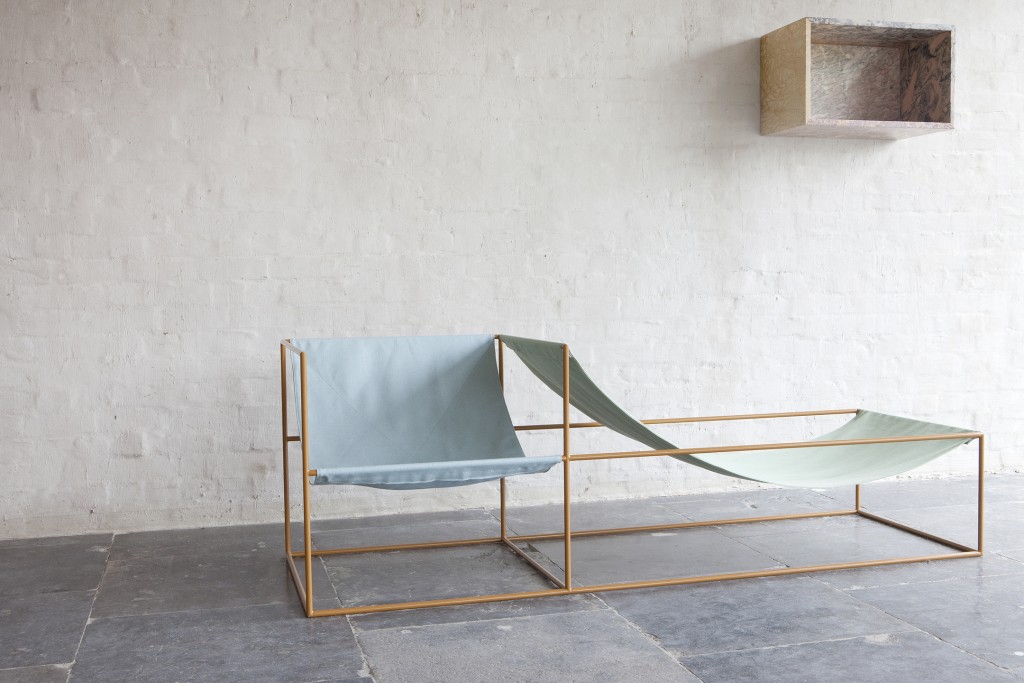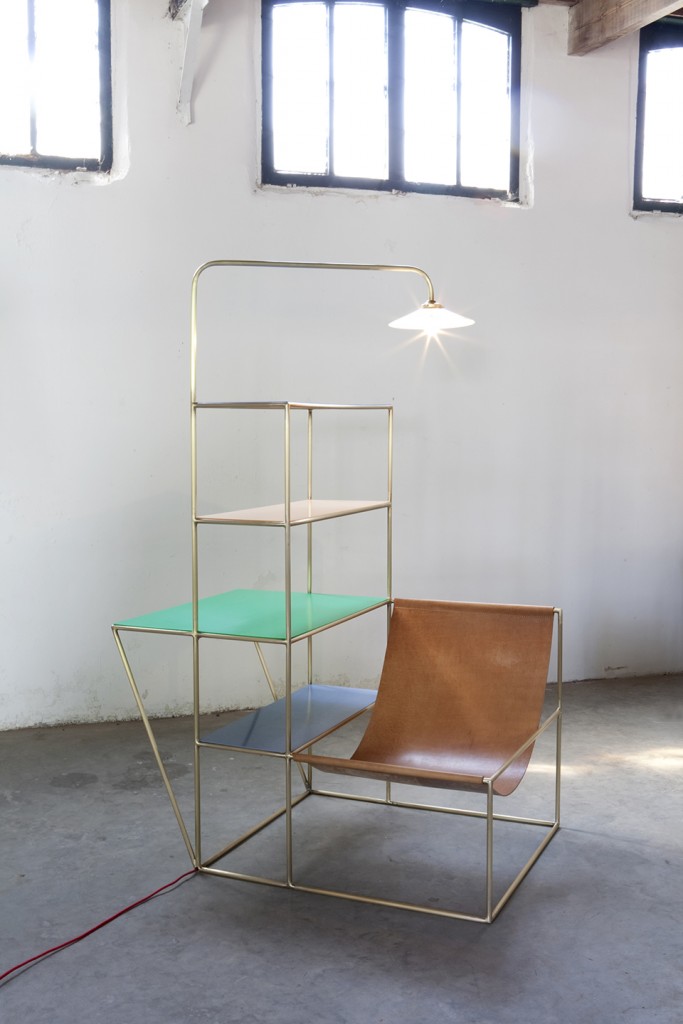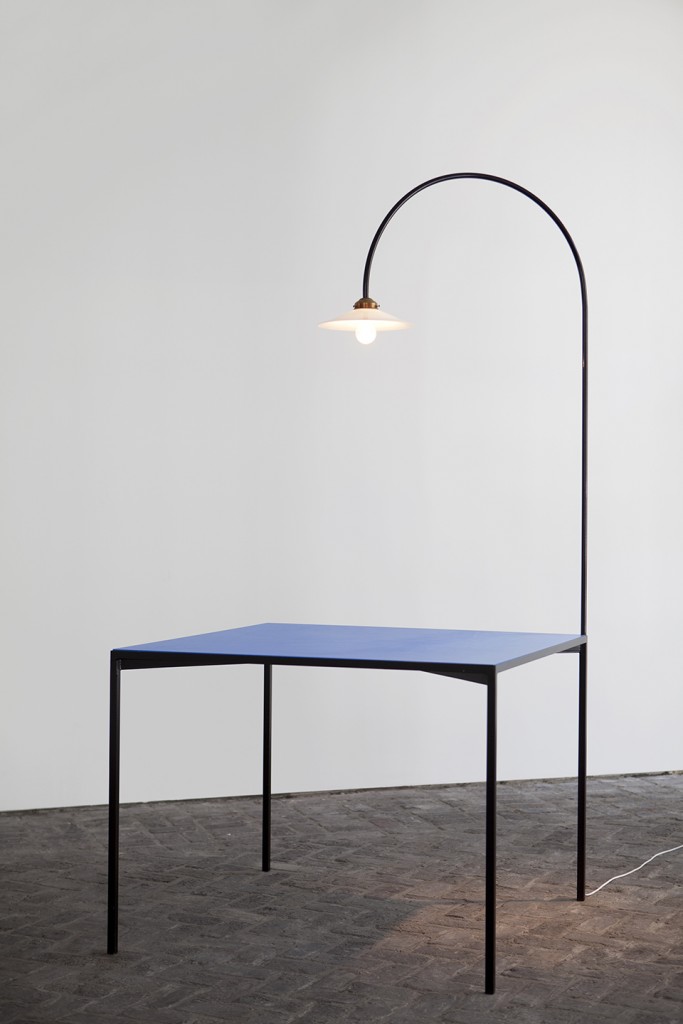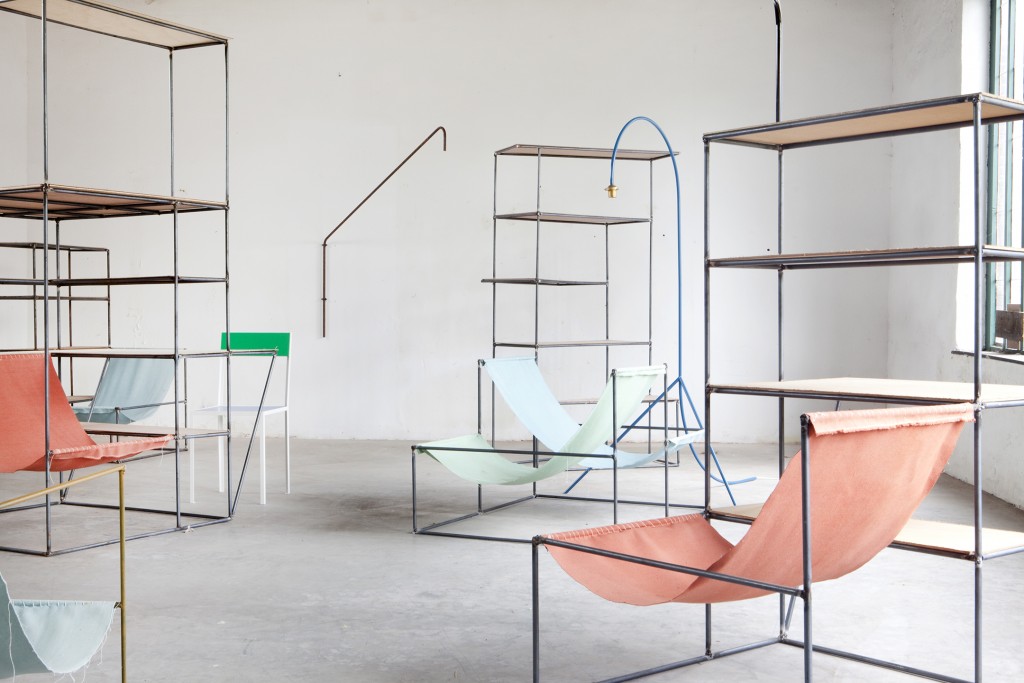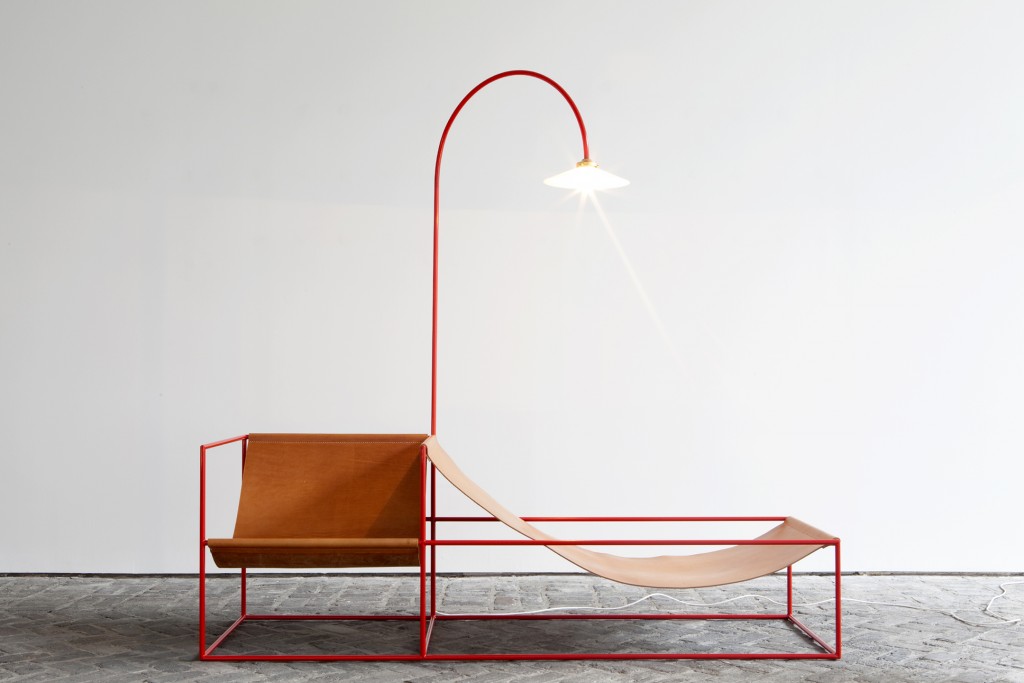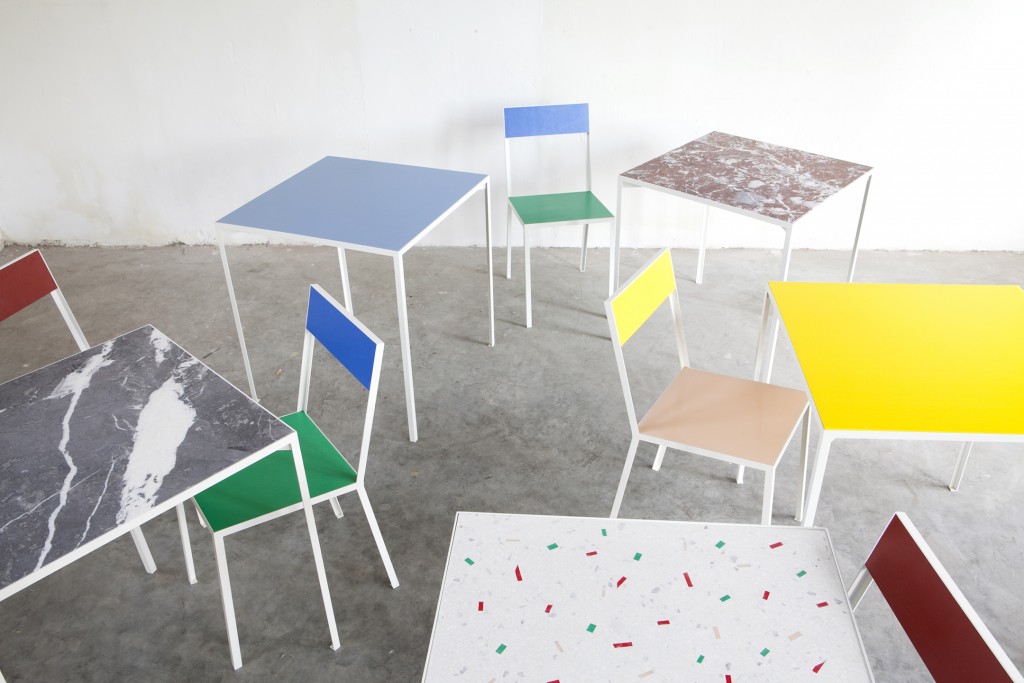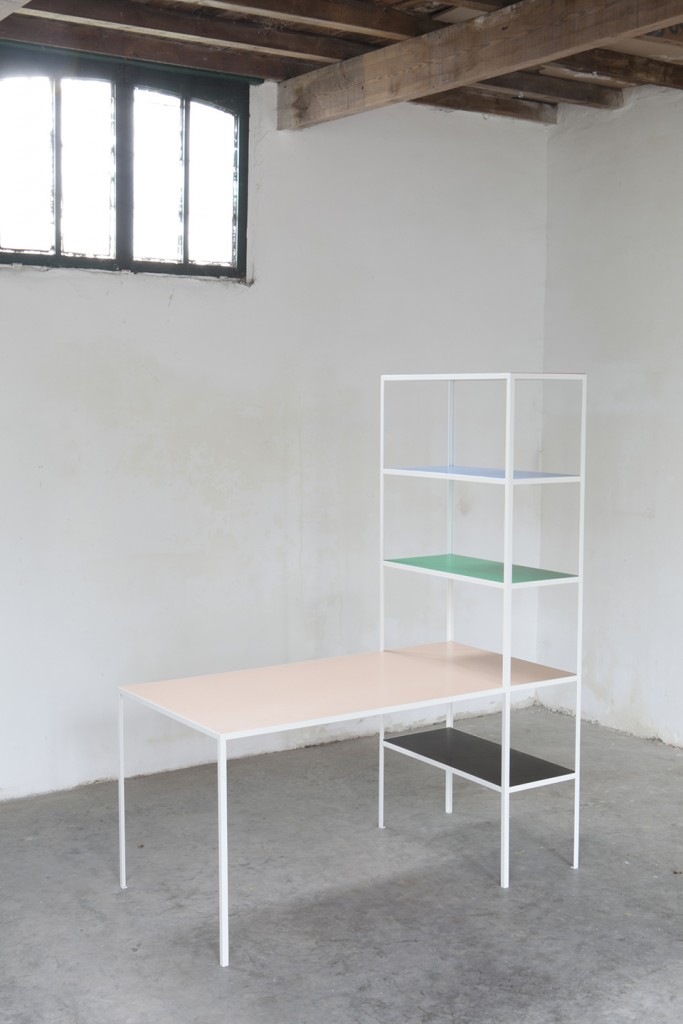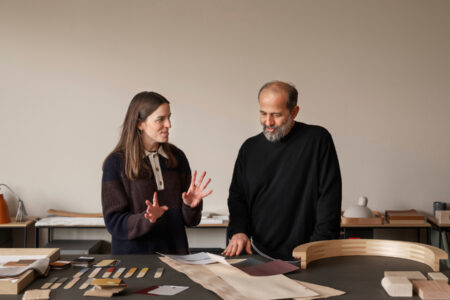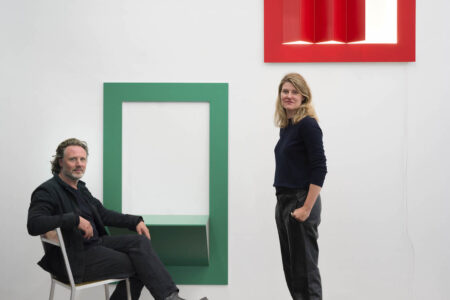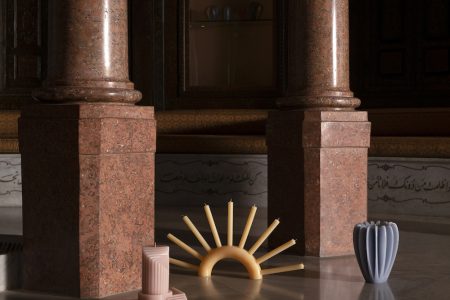Muller Van Severen: Complementing Contrasts
Muller Van Severen draws together contrasting elements as it combines two very different worlds and backgrounds of Fien Muller and Hannes Van Severen.
Muller Van Severen’s accolade for Designer of the Year 2015 in Belgium was a prelude to architectural projects, collaborations with Valerie Objects and Hermès and a solo show at Galerie Kreo in Paris, taking place next year.
In Fien Muller and Hannes van Severen’s work, a chair becomes a lamp, a shelf twists around itself like stairs and another two cross and tangle with each other. Delicate marble meets strict minimalist forms of a box and a bench. Together, they become creatures communicating with each other, a crowd of creatures mingling, nodding to each other, laughing, glancing or turning towards and away from each other.
The collection draws together contrasting materials, elements and colours as it combines two very different worlds, backgrounds and families of the designers. The furniture is playful, both feminine and masculine, and they are silent and delicate rather than shouting.
After sharing their lives for years, but working individually on their own work – Muller on sculpting, photography and video and van Severen as a sculptor – they came to work together on a collection of furniture. This year, the collaboration earned them title of the Designer of the Year in Belgium. Today, they work only as Muller Van Severen instead of continuing with their individual works.
“We think the same way together than we did as individual artists, but now we think in a new medium, furniture, which is art and furniture together. Even if they are not used as furniture, they are kept as a beautiful thing to look at,” Fien Muller states.
“It’s the same satisfaction to work on the furniture collection as working on our individual work. We are really enjoying this,” Hannes van Severen continues. “When we started doing this, friends said ‘you can really see you and Fien’s worlds coming together in these furniture.’ It’s nice to hear this. If we compose images of our individual work and the furniture, then we can see it – it’s really like a family.”
“But it’s also strange, because you made this furniture and then you can see how much individual work has connected. It was a symbiosis, actually,” she points out.
Baroque Minimalism
Fien Muller and Hannes van Severen come from very different backgrounds and families. Whereas van Severen’s family is known for modernist, straight and strict lines and forms, there is a different colour in each of the rooms in Muller’s artist family’s house, as well as an eclectic mix of antiques and contemporary art.
“In the beginning, I wondered ‘what is this’ when I came to Fien’s parents’ house,” van Severen laughs. “But in the years we’ve been together, we have started to understand both of the families. Fien’s parents have a very good taste and I have started to like that world a lot and understand that kind of a world. Also Fien understands the world I come from.”
Muller and van Severen deny that they were intentionally playing with each other’s visual worlds in their individual work. Still, Hannes van Severen worked individually on abundant forms and installations made of strictly cut antique cupboards, chests and wardrobes, whereas Fien Muller adopted strictly modernist, minimalist lines and colours in her individual artistic work.
“I think I wanted to simplify the antique cupboards by doing really sharp cuts. By doing a sharp cut in a piece of antique furniture you simplify it, so I actually made it my world,” van Severen reminds. “The connections might sometimes be very clear when you think about them afterwards, but when you make the work in the moment, you don’t think about it.”
“It’s never our meaning to make something together thinking of having both our backgrounds in it. It’s something that just comes out and is something we talk about afterwards. Marble boxes are maybe the best example. It’s strange for us to have the marble boxes – it’s a very strict box made of different colours and different kinds of marble. It becomes something very baroque. Also with the marble bench: the frame is strict but what’s happening in the frame is always playful,“ he continues.
When Muller and van Severen work together, a new piece often starts with little and grow through discussion.
“The process is always different. Sometimes we begin to work by seeing something; sometimes we start working on something when we find a specific material. And then, out of the blue, everything we have mentioned to each other in a few weeks time,” Muller snaps her fingers, ”comes together in a piece. The other one draws a little thing, and the other one sees something in it. It starts with something little, and then we start to talk. And it sounds strange, but we mostly agree on things.”
“We agree about the taste of something, like proportion or colour. Sometimes we are struggling, but we also accept when the other one says ‘I don’t like it’,” van Severen continues.
“I think that’s because we trust each other a lot in our work, that we can accept critical comments or we can discuss without an argument,” she finishes.
Expanding Projects
Muller Van Severen used to produce limited editions of the furniture by themselves. Now their work is distributed by Valerie Objects, a new Antwerp-based design label initiated by Axel Van Den Bossche, Frank Lambert and art director Veerle Wenes of Valerie Traan Gallery. In addition to Muller van Severen, Valerie Objects presents work by designers Maarten Baas, Studio Wieki Somers, Koichi Futatsumata, Jinhuyn Jeon and Studio Simple.
“We want to design new things for Valerie Objects. The pieces will be the same and the furniture will still be numbered limited editions, but it will be made by someone else, and we just do little finishings,” van Severen explains.
Partially enabled by the collaboration with Valerie Objects, Muller Van Severen has recently been asked to collaborate with architecture offices in architectural competitions as well as competitions to design public spaces. The duo is also collaborating with the Metropolitan Museum in New York in designing furniture for the restaurant of the new expansion of the Museum to the Marcel Breuer building, which was previously a part of the Whitney Museum.
The couple is also working on Petit H by Hermès for D’Days in Paris in 2016. Petit H is a company within Hermès recycling the luxury company’s surplus materials by asking artists and designers to use them in design and art pieces.
Next year, they will also have a solo exhibition at Galerie Kreo in Paris – when exactly, is yet to be decided, since the gallery prefers giving time to its designers and presenting the work when it’s done.
“We basically have the whole show ready, but we are still working on a prototype that we need to show to Kreo’s Didier Krzentowski,” van Severen says. “We will have the exhibition a month or two later. I would like to have the show in March or April next year, but I can’t really promise yet. But, soon.”
“From early on, we had a dream project and it was showing at Galerie Kreo,” Muller recalls. “When Hannes was 23 he always said ‘imagine, if you could do a show in Kreo’… We are very young to have the dream come true, but maybe we have to find another dream now. There are many different things happening, and my dream is to keep those things alive.”
“Now what we make for Kreo is very different from museums and restaurants, but it’s also the same world,” van Severen finishes. “It’s different, but you can feel it’s also family.” •
Muller Van Severen will also be part of exhibition Design Derby – Belgium Netherlands 1815–2015 running at Design Museum Gent from 23 October 2015–13 March 2016.
